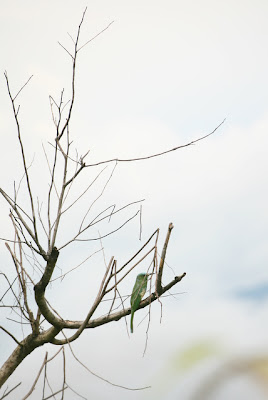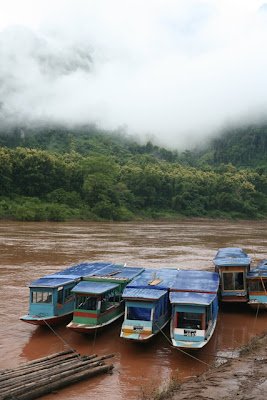Laos... Have you been here? One of the poorest countries in the world, and also one of the most beautiful.
Thank you for reading my friends! I am excited to recount more of Aiyanna and I's stupendous journey. This post will take you into the splendid mountains of Northern Laos-- the beauty, peace, and tranquility of life here, and also examine some of the many conundrums ongoing in this country. Read on, and look at the commonplace life of the small town street, observe the many moods of a rice field, trek with us through the jungle to a remote village, brave awful roads in frightening buses, and have a well earned rest along the Nam Ou river before finishing on the banks of Mekong at Luang Prabang, where you will have to wait for the next installment... Sorry, our excursion in Laos was just too much for one post.
Our trip in Laos started when we crossed the Mekong from Thailand, and our first stop after visas and passport stamps was Luang Namtha.
Thank you for reading my friends! I am excited to recount more of Aiyanna and I's stupendous journey. This post will take you into the splendid mountains of Northern Laos-- the beauty, peace, and tranquility of life here, and also examine some of the many conundrums ongoing in this country. Read on, and look at the commonplace life of the small town street, observe the many moods of a rice field, trek with us through the jungle to a remote village, brave awful roads in frightening buses, and have a well earned rest along the Nam Ou river before finishing on the banks of Mekong at Luang Prabang, where you will have to wait for the next installment... Sorry, our excursion in Laos was just too much for one post.
Our trip in Laos started when we crossed the Mekong from Thailand, and our first stop after visas and passport stamps was Luang Namtha.
We were greeted in the market by tribal Akah women: relentless bracelet pushers, but full of personality with their traditional head dresses and near toothless grins.
Laos is a very rural country, and agriculture is the primary occupation of its citizens. Here are some street scenes from Luang Namtha and Muang Sing, farther north, to give you an idea of what daily life is like.
Geese, as well as ducks and chickens, as well as every other farm animal, make their presence known.
Textiles are made locally, and sold aggressively. Here Aiyanna contends with local children selling scarves... In the end she couldn't say no.
These funny vehicles, a sort of tractor, carried everything from rocks, mud, logs, and most often, crowds of people riding to and from town.
The morning market in Muang Sing was a bustling affair in the early hours of the day. Here a man leaves loaded with goods for the day.
Laos is also a Buddhist nation, so monks young and old are a common sight.
We spent several very restful days in Muang Sing (where and when I began recounting our adventures in this blog) as I convalesced from the antibiotics I was taking. These rest days were a great opportunity to soak in the beauty of Northern Laos and observe the shifting moods of the rice fields beyond our guesthouse balcony.
Early morning mists...
Daily labors...
Rifts of monsoon clouds in the afternoons...
And evening illumination on dragon skies.
Northern Laos is an ethnically diverse area with tribal groups making up a more than significant portion of the population here. The Akah, Hmong, Khmu, and Lahu, among others, live in mostly homogenous villages all over the region. In order to see the life of the Akah as they have lived for many generations, we embarked on a trek to one of their many remote villages. We weren't really sure what we were signing up for in this trek... we knew there would be jungle walking (through the Nam Ha National Protected Area) and an overnight homestay experience, but not much more. It turned out to be quite an adventure, a good challenge for both of us.
Our trip started with a hike through this families farm, about an hour drive further into the remoteness from the already far removed Muang Sing. This family is growing rubber trees on their hillside since clearing it of trees; below are their rice fields.
Laos jungle is dense, dark greens. The trail was generally bad or worse, though occasionally it opened for some nice walking.
Luckily our guides knew the way, and this man, though he spoke no English, carried a bush knife he deftly wielded to cut the brush before us.
Lunch spread before us on a blanket of banana leaves. Yum!
One of the "bad"sections... you can imagine worse!
We explored this cave-- it was small, but rather exciting in an Indiana Jones sort of way.
The hiking provided a great opportunity to check out the jungle life. Please endure my following attempts at nature photography:
Ferns dotted with eggs at the edges.
This looked like strawberry and tasted like sour incarnate.
A bird, a bee eater? Beautiful.
Eight inches of millipede.
Most bizarre fungus award goes to... this weird looking guy.
Needless to say, the jungle is a great environment for mushroom mayhem.
What is that all over that tree? Let's take a closer look shall we...
Caterpillars! "No touch," our guide says. Ferocious friends!
Mating rhinoceros beetles.
After about 10 hours of hiking-- a mostly uphill fight through slippery deep mud, through waste high rivers, fighting angry briars, sweating in thick humidity before finally getting drenched by rain-- we arrived at the Akah village where we would spend the night. The high remote setting made for a beautiful location, but any romantic fantasies of village life quickly dissipated as we were confronted with scenes of a very hard life-- bad for the people, bad for the planet.
No plumbing in any of these houses, livestock going where they please: poop is a problem, especially when most of the children are barefoot.
Food is cooked over a fire, and the fire is indoors. The house where we stayed was constantly filled with smoke, not to mention that bamboo walls and grass roofs are not exactly flame retardant.
Here a woman goes to one of several springs for water. This is also where people bathe, do laundry, wash vegetables, etc. While this woman is old enough, we also saw very young children, like 5 and 6 years old, making water runs, carrying two full buckets over their shoulders. Hard as I tried not to judge a way of life and a culture situated to a time and place unfathomable to me, I couldn't escape my conclusion that this is no way to live. Change should come-- for the good of many.
Here are the high rice feilds of the Akah village we observed; a beautiful scene until you observe the following:
This photo shows the charred stumps of a once-forest. The Akah practice slash and burn agriculture: they clear a section of mountain, burn, and then plant rice for one season before abandoning the clearing to be overtaken with rough brambles. They slash and burn again and again, year after year, deforesting at a completely unsustainable rate.
The next day, many more hours of walking. It was really exhausting, but very good to be out in nature in totally unfamiliar territory.
And of course, hiking has its rewards, such as this beautiful waterfall...
And this beautiful view. Trek finished, we had a lot of new information to process. On the one hand, we had encountered up close the beautiful landscapes and incredible diversity in nature on tap all over Northern Laos. We had gained an appreciation for the ruggedness of this land, and witnessed the seemingly unstoppable forces of the jungle. On the other, we were beginning to understand the struggle of poverty facing the majority of people here. Our guide talked to us in his broken English about the corruption of the government, about the selling out of Laos land to the Chinese, and about his own rubber tree farm on his own bit of clear-cut mountainside. These same perplexing mixes of an awesome natural beauty aside a despairing social poverty would follow us all over the country.
We left Muang Sing and began our gradual southward journey through Laos. Bus rides were almost always arduous affairs here: the roads in the north are terrible, especially during monsoon season as there are frequent landslides that cover the roads, deep breaks in the road, and soft mud that seems as if it should just give way to our overloaded and top heavy bus. This picture shows the narrowness of the roads, and the size of the vehicles passing. Of all those dangers, the speed of the buses is certainly not one: they travel very, very slowly. To go 100 kilometers could take as long as 6 hours.
I rarely take pictures from the bus, but sometimes it's worth trying. Bus rides often took us through some of the most beautiful scenery as we made mountain passes and traversed our way up and down past villages and vistas.
A German fellow who goes to the jungle to collect moths for museums wanted to show us this unusual cricket, and I wanted to show you!
Those jarring bus rides got us to this beautiful riverside bungalow in Nong Kiaw.
The Nam Ou River splashes by he karste cliffs that surround the town.
Ah the river... The people here washes themselves, their clothes, and their food in these waters. Simultaneously, the same people throw in their trash, and wash away their personal waste, in the same water. Yuck.
A loom in one of the village houses. Laos weaving would be something I'd want to take home with me.
Scenes from the village.
The river at night.
A man standing among the holes of recently removed land mines. Laos still has a lot of unexploded ordinance and land mines to clear, part of the sad history from this region.
We explored this cave that local people used as a refuge during American bombing raids during the Vietnam War.
Looking out the cave.
Looking in the cave, a message for everyone.
When it was time to leave Nong Kiaw, we boarded one of these "slow boats" down the Nam Ou. It was a 5 hour journey through some very beautiful country.
Karste mountains in mist as seen from the river.
The "Buddha Cave" along the Mekong River; getting close to our destination Luang Prabang!
Here I am on the boat. Hi everyone!
OK-- you've reached the end of this post. Thank you for reading! Stay tuned, as there is still more to come. Next time I will show you the magnificent city of Luang Prabang and the powerful waterfalls around there; I'll tell you about what crazy business is happening in Vang Vieng and show you the most beautiful scenery from the whole trip; and then finish Laos with some seriously earned R&R in the far South on Si Phan Don-- 4,000 Islands. Of course, this is all past tense... In the present moment, I am writing these final lines from Siem Reap, Cambodia, on our last night here before we buzz back to Bangkok. Three more days before we officially enter the time frame reserved for Chapter 4 on the West Coast. California: see you soon! South East Asia, I'm gonna miss you...
Thanks everyone! Much love, best wishes to all; see you when you see me.






















































No comments:
Post a Comment